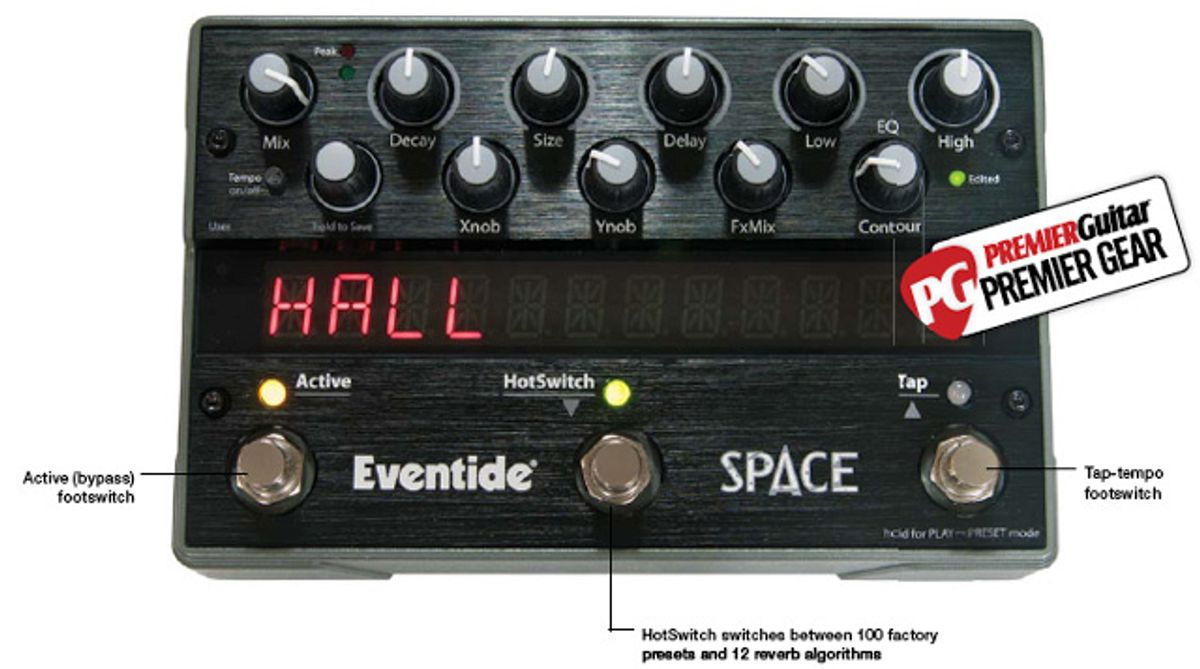
As any Gregorian monk worth his robe can tell you, reverb is one of the most effective effects you can use to enliven an otherwise dull and not-happenin’ tone.
As any Gregorian monk worth his robe can tell you, reverb is one of the most effective effects you can use to enliven an otherwise dull and not-happenin’ tone. From cavemen in the canyons to cathedral chants at Chartres to the Chantays riding “Pipeline,” we’ve listened in wonder at its ability to add dimension, color, and a sense of space.
It’s no coincidence, then, that Eventide elected to use that very word to name its new hyper-packed reverb stompbox. The range of reverbs inside this single sexy box can seem as expansive as the cosmos itself—100 factory presets derived from 12 basic algorithms that can also be tailored to your needs. It runs the gamut from standard room and classic spring reverbs to the positively extraterrestrial.
This is a deep pedal—deep in sounds and functionality—that distills a lot of the great work Eventide has done with rack units like the H8000FW and H3000 SE. And the entirety of what the Space does could fill the pages for 10 reviews. But even a casual session with the Eventide Space reveals that it can lure you in for hours, and if you’re an incurable texturalist who loves to paint in broad strokes and subtle washes alike, the Space has virtually endless treats in store.
As Vast As the Sky
Like most of Eventide’s stompbox line, the Space can look daunting at first glance. It has 11 knobs and three footswitches, as well as a red LCD display glowing with occasionally cryptic readouts. But the Space works quite intuitively once you get the hang of a few basic functions. You will have to spend some time with the manual, but you can still get cool sounds quickly and with minimum effort.
Each of the Space’s sounds is born of 12 basic reverb algorithms—including Hall, Room, Plate, Spring, and Reverse—in addition to more esoteric algorithms like Mangledverb (which distorts and detunes reverb tails), Shimmer (which shifts pitches in reverb tails and lends a touch of harmonizing), and Blackhole (which lends an overtone-rich, more-spacious-than-space feel). One of the trickier things is that, apart from the Mix control—which blends wet and dry signals—knob functions change depending on the algorithm.
The footswitches also have variable functions. In the most basic setup, the Active (bypass) footswitch turns the effect on and off, and the HotSwitch and Tap footswitches scroll through algorithms or presets (as indicated by the down and up arrows next them).
Interstellar Voyage
Consider this a fair warning to guitarists who don’t have a lot of time to spare or who have impatient bandmates: This pedal will suck you in. And as an insatiable fan of psychedelic, dub, and space-rock sounds, I immediately plugged in my Telecaster, ran the Space into a Fender Champ, and searched out the Blackhole setting. One of the beautiful aspects of the Space’s performance is that even the most radical algorithms and presents can be scaled back to very subtle or almost imperceptible versions of themselves—or propelled to serious extremes. You can also modify several tone-shifting parameters. For instance, on the Blackhole setting alone you can move decay from super long to long-and-inverse decay (for a cool suction-like effect), apply and adjust delay to the effected signal, increase or decrease the size of the reverb (a sort of littlescreen/ widescreen effect where you can cut or boost highs and lows in the reverb tail, adjust the speed and intensity of modulation, and increase or decrease resonance).
Even at fairly tame settings, the Blackhole algorithm is overflowing with expressive potential. Dial back the Decay, Size, Delay, and Mix knobs, and you can add a ghostly quality to, say, a fuzzy or overdriven blues solo. But dial everything back up between 11 and 2 o’clock, and the simplest strum of a chord finds you stretching time and covering light years.
The Shimmer algorithm is also bound to please ambiently concerned players. And if you’re a fan of Daniel Lanois or the Edge’s work with reverbs and harmonizers—particularly the ethereal sounds on The Unforgettable Fire—the rich, celestial, and orchestral textures this setting lends to a clean Fender tone will leave you giddy and dreaming.
The Space isn’t all deep, cosmic travelling, though. The Spring algorithm sounds natural and rich, particularly at more mellow settings. And with my detuned Telecaster, it conjured images of a dusty spaghetti Western sunset. The hall and plate reverbs were both beautiful sounding when I ran a Martin 00-15 with an L.R. Baggs iBeam out in front—enlivening fingerpicking phrases and complex chords. Probing further into the factory presets (which include presets from artists like Vernon Reid, Sigur Ros’ Jonsi, U2 producer Flood, and electronic music producer Richard Devine) revealed even more mind-boggling possibilities.
The Verdict
You could spend an entire rainy weekend with the Eventide Space and only scratch the surface of what it can do. The basic algorithms and presets alone could probably inspire hundreds of fresh approaches to solo sections and songs. But the seemingly limitless tweakability and range of the pedal, as well as the ability to save personal presets, have the potential to make it the busiest pedal on your board or in your studio. For puritanical players, the Space will offer a thousand more textures than they need, especially given a street price of around 500 bucks. But for true 6- and 12-string adventurers eager to explore the final frontier, the Space has the power to be endlessly rewarding.
Buy if...
texture is your king and you have little use for guitar-tone dogma.
Skip if...
you haven’t turned the Reverb knob on your Twin Reverb past 2 in ages.
Rating...
Street $499 - Eventide - eventide.com |

